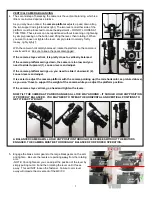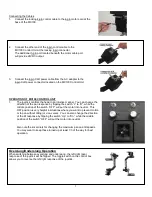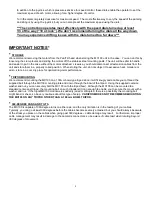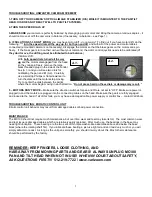
4
In addition to the joystick, which is pressure-sensitive for speed control, these dials enable the operator to set the
maximum speed of each motor, allowing for a higher degree of control.
Turn the dials completely clockwise for maximum speed. The most effective way to vary the speed of the panning
and tilting is by using the joystick, but you can also preset the maximum speed using the dials.
***The control box operates most effectively with the speed dials turned up at least
1/3
of the way (“10 o’clock”). We don’t recommend turning the dials all the way down.
You may experience drifting issues with the dials turned too far down.***
IMPORTANT NOTES *
*
STORAGE
We recommend removing the motors from the Pan/Tilt head when storing the MC100 unit in the case. You can do this by
loosening the clamp levers and sliding the motors off the stainless steel mounting posts. The unit will be safer to handle
and easier to put in the case without the motors attached. Likewise, you should disconnect all extension cables from the
unit and store them in a properly coiled position. When storing the unit, do not subject it to excessive heat, moisture or
dust
– store in a cool, dry place for optimal long-term performance.
*
TRIPOD MOUNTING
We recommend mounting the MC100 on a 100mm bowl-type tripod since it will fit snugly and enable you to thread the
supplied bolt through the MC100 mounting plate and down through the bowl of the tripod. Using the supplied oversize
washer and nut, you can securely bolt the MC100 onto the tripod bowl. Although the MC100 can be mounted to a
standard center-post trip
od, the mounting bolt on such tripods isn’t long enough to enable you to secure the mount with a
washer and nut. If the tripod/MC100 mount were suddenly jarred or disrupted, there is a possibility the mounting bolt
might bend or shear, so be very cautious about this type of setup.
VARIZOOM DOES NOT RECOMMEND MOUNTING
THE MC100 ON ANY TRIPOD OTHER THAN A 100 mm BOWL TRIPOD.
*
360-DEGREE PANS AND TILTS
The MC100 is capable of 360-degree turns on either axis, and the only limitation is in the twisting of your cables.
Typically, you can go at least 360 degrees before the cables become severely entwined, but you should always be aware
of the stress you place on the cables when going past 360 degrees
– cable damage may result. Furthermore, improper
cable m
anagement may result in damage to the camera’s connectors,
so be aware of cable twist when rotating beyond
360 degrees of movement
.























